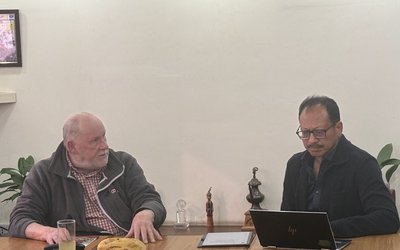
How do you highlight the success of MEDEP?
It is one of the successful programs of Nepal. MEDEP has developed over 70,000 micro-entrepreneurs including 68% women, 20% Dalits and 67% youth. At a time when there is a lack of jobs, it has created over 75,000 sustainable jobs. It is very interesting to say that eighty percent of MEDEP enterprises continue to do business.
How do you see the change in the income?
Those who joined MEDEP as micro-entrepreneurs are making over twice the money they used to earn before coming into contact with the Program. Along with generating employment, the program has promoted business support service organizations in all the 38 districts. After the completion of the training, the micro-entrepreneurs have established micro-entrepreneurs associations. The association is sharing with their members advocacy, technology, access to finance and other scale-up supports. The program reduces poverty and hunger by increasing the incomes of poor rural households. It also promotes gender equality and empowers women, improves the school attendance, the health of women and children by improving the income of women.
How do you replicate MEDEP?
With the major success by MEDEP, we are now replicating the MEDEP model terming it Micro Enterprise Development for Poverty Alleviation MEDPA and it will be implemented in all 75 districts. Kesha Pariyar, Chairperson of the MEDEP promoted Entrepreneurs' National Organization – National Micro Entrepreneurs' Federation Nepal (NMEFEN), was awarded internationally acclaimed Business for Peace Awards 2014.
What is in the stage of Micro-Enterprise Development Program?
This project started in 1999 under the UNDP support and it has already completed almost 15 years. The government has been internalizing the program with an aim to generate employment and alleviate poverty. This is an effective and exemplary program launched with support from UNDP.
Why is this important?
This is an important program to generate employment opportunity and alleviate poverty. The beauty of this program is that it is inclusive as well and tied up with national policy. The target group of this project is marginalized, Dalit and poor ethnic community. This program aimed at poor and marginalized community of remote parts of Nepal. This is popular as well as effective so far after its launch jointly by Nepal government and UNDP. The project has already created more than 60,000 micro entrepreneurs. Other important component is that its target group is the population below the absolute poverty line. We direct the programs to the hardcore group within the population living below absolute poverty line. Our target group includes the poor among the poor. In terms of gender, it is very much gender friendly as over 68 percent of beneficiaries are women. This is one of the major programs to empower women. The women include illiterate. There are some women who have benefited from the project. The project shows how economic empowerment can make women socially powerful.
How do you assess the program?
The program helped to establish over 60,000 micro entrepreneurs. We also help to unite them under their own interest. There are various kinds of organization to protect the interest of groups. The micro-entrepreneurs have also Federation of Micro Enterprises with all the members.
How long has the government been involved the program?
Nepal government has been internalizing the program since last four years. We have internalized the program with MEDP for Poverty Alleviation MEDEPA. MEDEP was in 38 districts and we are in the process of expansion. We have developed a strategy plan for coming five years. The name of strategy is Micro Entrepreneur Enterprise Development for Poverty Alleviation (MEDEPA). We have also guidelines for the program. Our strategy aims to create another 73 thousand micro-entrepreneurs by 2018.
How will it transform into a new program?
This program will transform from MEDEP to Micro Enterprises Development Program for Poverty Alleviation MEDPA by 2018. MEDEP’s districts will gradually wind up and they will be replaced MEDPA By 2018. MEDEP program is still operating in 38 districts and they are now supporting MEDEPA’s successful implementation. MEDEP will provide logistic and capacity building support to MEDEPA.
What is the modality of MEDPA?
MEDPA will be implemented by District Offices of Department of Cottage and Small Industries. We are also looking at whether our district offices are capable enough to run the programs like MEDEP. If not where are the gaps? The ongoing fourth phase of MEDEP is directed to see the gap in the implementation. As the fourth phase launched, we have developed a common document to shift to MEDPA. But we are following the guidelines prepared by UNDP. However, one of the major objectives of MEDEP is now to make implementation of MEDPA successful. The program will also support in the process of internalization of program. There will be no more extension of MEDEP. MEDPA will be extended in all 75 districts.
What strategy do you have for the transition?
We have five years strategy with funding modality and working modality. We have common program. For MEDPA, Nepal’s development partners will contribute 67 percent of the total resources and Ministry of Industry will contribute 25 percent and 8 percent by the local bodies. So far as the support of development partners is concerned, currently only Australian Aid has been providing fund and other development partners have also shown the interest to support the program. Our budget is over 4 billion for the project.
How are DDC and other local bodies involved in the program?
Each District Development Committee has the Micro Credit Fund and they will contribute eight percent in the fund. All this money will go to Micro-credit Development Fund. There is a Micro-Credit Development Committee in each district headed by Local Development Officer and the member secretary of the committee will be the head of District level Cottage and Small Industry unit. The committee will approve all the programs for the district and the money will be spent through Cottage and Small Industry office.
As your program is in dire need of resources, how do you see the response of Nepal’s development partners?
Nepal’s development partners have expressed that they will provide resources for district level funds. They have also said that the government should take ownership and DDCs are given more roles in implementing the program. The government sees this is also part of decentralization.
What are the challenges?
One of the major challenges is the funding. Although other development partners have also shown interest, they are yet to come with funds. Ministry of Industry needs to take certain initiatives to persuade Nepal’s development partners. We need to cultivate other development partners. MEDEP has much flexibility. As MEDEPA is under the government, there are many restrictions. As District Micro-entrepreneurs Committee is very large, one has to face much difficulty to clear the project.
- MELAMCHI WATER SUPPLY: No Interruption During Monsoon
- Jun 25, 2025
- KOREAN RETURNEES: Successful Integration
- Jun 25, 2025
- UPPER TRISHULI-1: Engaging With Local
- Jun 25, 2025
- IME GROUP: Twenty Five Years Of Journey
- Jun 24, 2025
- NEPAL’S AIR POLLUTION: A Growing Health Concern
- Jun 24, 2025















